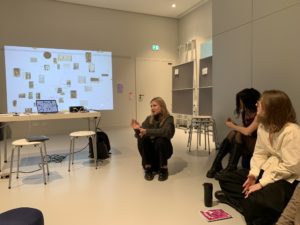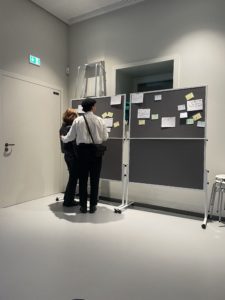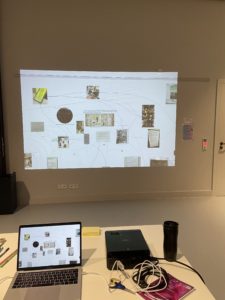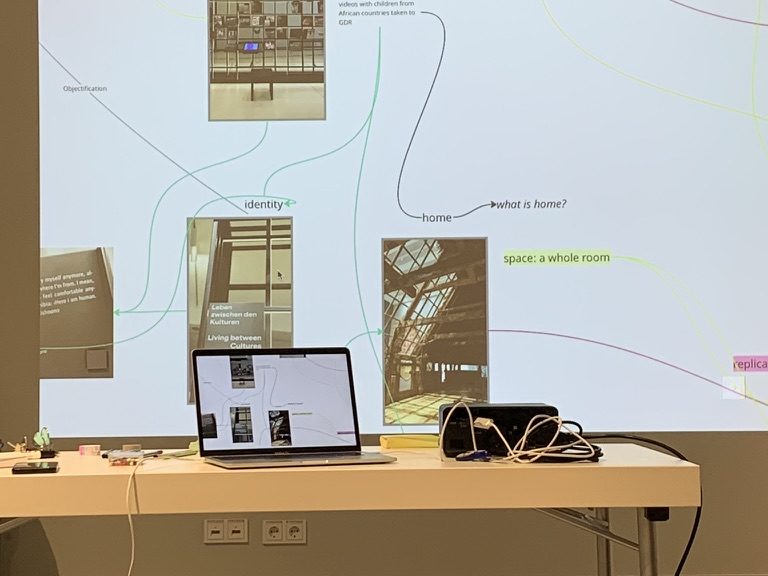
Stumbling upon unhelpful information on individual museumized objects-subjects and their diminishing classification within the museum space, we propose an alternative: Our project endeavours to illuminate an intricate web of relations among various elements – so-called “objects”, wall texts, art interventions, media tools etc. – exhibited in the Humboldt Forum, and expand it beyond the museum space – for example to the collection’s depot or to global processes.
One of the challenges we confront is the varying description of museum objects. Some items are richly detailed, providing historical facts, provenance, materials, and usage, each creating distinct contexts. In contrast, others offer minimal information, containing only geographical origin, title, and date. This discrepancy prompts essential questions about the multifaceted nature of these objects-subjects. Are they to be regarded as art, cultural artefacts, religious items, historical relics, or are these categories not applicable at all? It also raises questions about the hosting institution itself, considering the politics of its (re)construction, dealing with collections, positioning on the outside, and surrounding local and global processes and discourses. Is all of this a product of conspicuous consumption during the colonial period, a political decision, an educational resource, or a centre for research? We question the necessity of rigid definitions and advocate for a more open, interpretive approach.

We aim to foster visitor engagement by inviting people to actively contribute to the discussion about exhibitions located in the Humboldt Forum. We have created a digital map to display connections between museum objects, which visitors can edit on their own smartphones or provided tablets. Displayed in the workshop room, it is accompanied by a discussion board where visitors can share their reflections on questions we pose. Our initiative is a response to the pressing need for enhanced contexts and accessibility of information, which in our view, should circulate in various directions between visitors and related communities, external and internal to museum experts. We are creating an open and experimental space for knowledge exchange which challenges power relations in knowledge production and gives room for diverse perspectives. We seek to break away from conventional organizational methods, fostering instead a participative and reflective approach to explore the exhibition. In conclusion, “Mapping Connections” challenges traditional museum practices, offering a novel and inclusive way to explore and respect the diverse cultural heritage housed in museum exhibitions. Our project empowers visitors to actively participate in co-creating narratives by fostering a dynamic and multi-layered collective understanding of the museum’s collections.
Format: Interactive digital board with miro, in the exhibition space: feedback board
Materials: Miro board, beamer, tablet, stickers

About the contributors:
Karina Belik is a master student of European Ethnology at the Humboldt University and a student assistant in the Department for Strategy in the Stiftung Humboldt Forum im Berliner Schloss. In her research, she explores cultures of remembrance in Russia, relations between remembrance of the WWII and the current war of Russia against Ukraine, related Russia’s colonial policies, and decolonial and solidarity initiatives as well as artistic practices.
Polina Shablovskaia is currently pursuing her master’s degree in Interdisciplinary Studies of the Middle East at Freie Universität Berlin. Her educational background is marked by her master’s in Linguistics from Saint Petersburg State University as well as a bachelor’s degree in Oriental and African Studies, which she completed at the same institution. Polina’s research interests are diverse and encompass the history and culture of the Middle East and cross-cultural communication challenges, reflecting her dedication to interdisciplinary scholarship.
